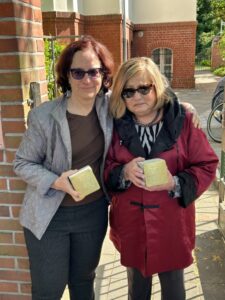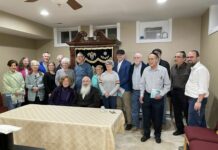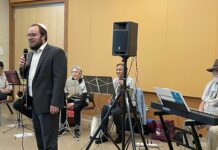
Tens of thousands of Holocaust victims and survivors have been honored throughout Europe, with special stones and plaques placed at the sites of their last address of choice.
Baltimore area sisters Judy Gartner, 67, and Susan Oberfeld, 78, encountered the world’s largest decentralized monument to the Holocaust in a trip to Berlin in May to memorialize their grandparents.
Gartner, her husband Randy and Oberfeld attended a sidewalk ceremony on Lynarstrasse for the laying of Stolpersteine, literally a “stumbling stone,” in memory of Friedrich and Ella Weiler.
The Weilers were deported to Theresienstadt and then transported to Treblinka in 1942, where they were likely gassed, said Judy Gartner of Ellicott City.
The Stolpersteine are concrete blocks measuring four-by-four inches that are laid flush into the cobblestone in front of the victim’s home. Names, birth year and fate (fled or perished) are hand engraved into a brass plate on the top of each stone.
About 100,000 stones in 30 countries and in two dozen languages have been laid in a grassroots memorial project started 31 years ago by German artist Gunter Demnig. At least 1,200 places in Germany have Stolpersteine installations.
Gartner remembers traveling to the Jewish quarter in Slovenia and seeing the stumbling stones on the ground.
She got directly involved with the Stolpersteine project through a friend’s coworker who had gone to Berlin for her family’s ceremony.
At her suggestion, Gartner filled out an online application with details she knew about her grandparents. A year later, she was contacted by Angelica Hermes, a researcher in Berlin who was working as a volunteer for the Stolpersteine project. Gartner said her job was made easier by the fact that the family had supplied information about the Weilers to the U.S. Holocaust Memorial Museum.
Gartner is a clinical social worker and member of Beth Shalom Congregation in Columbia and Moses Montefiore Anshe Emunah Hebrew Congregation in Baltimore. She has been involved in Howard County’s Yom HaShoah program for 10 years.
COVID-19 and other health setbacks delayed the sisters’ plan to participate in the ceremony, Gartner said.
“My sister and I discussed whether we wanted to be there and there was no question about it,” said Oberfeld of Hunt Valley. “We felt it was a wonderful way to memorialize our grandparents who unfortunately we never met, we never knew. The only knowledge of them was through our own parents who were fortunate enough to escape Hitler’s Germany and come to Baltimore where they met and married.”
Hermes offered many biographical details about the Weilers during the ceremony. Friedrich Weiler was a well-respected merchant who fought for Germany on the eastern front against the Russians in World War I. For his bravery, he received the Iron Cross. He ran a successful seed and feed business in Brakel in Germany’s Westphalia region. The family was forced to liquidate the business in the mid-1930s as antisemitism intensified. Later, Friedrich and Ella Weiler and one of their two grown children, Carl, moved to Berlin, hoping a big city would be safer for Jews. They were wrong. Their son, Carl, became a judge, but was forced to quit by the Nazis. He fled Germany for the U.S. in 1930s, eventually arriving in Baltimore, where he met his wife, Mina, also a German refugee.
Gartner, who studied in Germany for a year abroad, understood most of the German that was spoken during the half-hour ceremony.
Hermes described its purpose to the two dozen who had gathered.
“An inhuman bureaucracy had degraded the deported people to numbers, wanting to erase their names,” Hermes said in her translated written remarks. “The Stolpersteine are intended to give these people back their names, their identity, their dignity and to keep their memory alive. Because a person, whose name is forgotten, dies a second time in Judaism. By laying the stone in the public space in front of the homes and by stumbling over the names on our way, the memory is included in everyday life.”
An accordionist played Jewish melodies as a volunteer laid the stones in the cobblestone flat to the ground. Two pictures of the Weilers were posted on the front gate of the house where they had rented an apartment. Those who stood there carried white roses to lay on the stones.
Quite a few of the participants were neighbors who lived on the street. The woman who owns the house was there with her 10-year-old son. She promised Gartner and Oberfeld that she would take care of the stones.
Gartner asked if a poem written by her father on board the ship that sailed to the U.S. could be read by one of the speakers. The request was honored.
“It was extremely emotional. When I think about it now, I can start crying,” said Oberfeld, a retired social worker and member of Baltimore Hebrew Congregation.
“I guess you get a feeling of closure,” Gartner said. “There’s no date of death, no yahrzeit, no cemetery to visit. So here was a place that hopefully people will look and remember what was very moving to me.
“By having this ceremony,” Gartner said, “they’ve taken some ownership of the past, of what happened and they’re still trying to remember and memorialize people.”
“You get a whole different feeling about the German people,” Oberfeld said. “The fact that they want to make up for what Hitler and the Germans did to the Jewish people in the ‘30s and ‘40s. I got a very warm feeling from all these people, none of whom were Jewish.”







